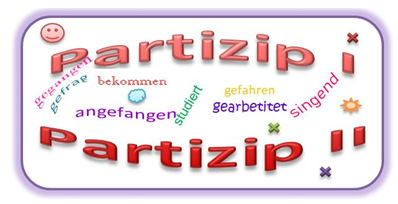In this lesson, you will learn all about German Participle I and Participle II, how they are formed, where they are used and what they mean.
Thank you for reading this post, don't forget to subscribe!CONTENTS
What is the participle in German?
What do we need to know about the participle II?
Construction of participle II in German
Use of participle II
What do we need to know about the participle I?
Construction of the participle I in German
The use of the participle I
What is the participle in German?
In contrast to English, where present participles are used in verb conjugations, German present participles do not serve this function. Instead, they act as modifiers. In German, the participle is an impersonal verb form.
There are two types of participles:
1. Participle I (present participle)
2. Participle II (past participle)
Let’s start with Participle II, also known as the past participle. This term is familiar to students of both German and English, as it is often referred to as the third column in the list of irregular verbs that everyone has to learn.
You may be wondering if that’s all there is to Participle II and if that’s enough to know. Unfortunately, that’s not the case. We need to cover a few more details to enhance our understanding, but don’t worry; it’s not overwhelming. Trust me on this!
What do we need to know about the participle II?
The perfect participle or participle II is used to express actions that have already happened, that is, they have been completed.
Construction of the participle II in German
| REGULAR VERBS | ge+verb stem+(e)t | ge+mach+t ge+arbeit+et auf+ge+mach+t | gemacht gearbeitet aufgemacht |
| IRREGULAR VERBS | ge+changing verb stem+(e)t | ge+komm+en ge+gang+en | gekommen gegangen |
| SEPARABLE VERB PREFIXES | ge is inserted between prefix and verb | auf+ge+mach+t an+ge+komm+en | aufgemacht angekommen |
| INSEPARABLE VERB PREFIXES | ge is NOT added here | besuch+t bekomm+en | besucht bekommen |
| VERBS ENDING IN -ieren | ge is NOT added here too | studier+t | studiert |
Use of participle II
1. Participle II forms complex active and passive verb forms such as perfect, pluperfect, future II, and passive.
For example:
Er ist angekommen. – He has arrived.
Ich habe ein interresantes Buch gelesen. – I have read an interesting book.
Er hatte einen langen Brief geschrieben. – He had written a long letter.
Es wird viel darüber gesprochen. – There is a lot of talk about it.
2. It can also be used as an adjective.
a. when it stands alone in a sentence and remains unchanged.
For example:
Das Auto ist gebraucht. – The car is used.
Here the participle II in the adjective function never changes its form. Here is an example with a plural noun:
Die Autos sind gebraucht. – The cars are used.
As you can see the adjective gebraucht remained unchanged.
b. when used as an attribute participle II is declined as an adjective.
For example:
Das gebrauchte Auto ist kaputt. – The used car is broken.
If the participle two is used as an adjective before a noun, it adapts to the noun.
3. it can also be used as a noun
The following perfect participles are very often used as independent nouns.
For example:
| Participle II | Nouns | English |
|---|---|---|
| abgeordnet | der/die Abgeordnete | the deputy |
| angehörig | der/die Angehörige | the family member |
| angeklagt | der/die Angeklagte | the accused |
| angestellt | der/die Angestellte | the employee |
| beamtet | der/die Beamte | the civil servant |
| betrogen | der/die Betrogene | the deceived |
| betrunken | der/die Betrunkene | the drunk |
| gefangen | der/die Gefangene | the prisoner |
| geliebt | der/die Geliebte | the lover |
| verdächtigt | der/die Verdächtigte | the suspect |
4. It is also used for commands
For Example:
Achtgegeben! – Beware!
Rauchen verboten! – No smoking!
Click on:
Grammar Contents
What do we need to know about the participle I?
The participle I is used when you want to emphasize that different actions are happening at the same time or that the action is happening at that moment.
Construction of the participle I in German
Participle I is also known as present participle. It is formed by adding a suffix -d to the infinitive of the verb.
For example:
singen + d = singend
gehen + d = gehend
spielen + d = spielend
Exceptions
We add -e- to the verbs tun and sein to make them easier to pronounce.
For example:
tun+ d = tuend
sein + d = seiend
Use of participle I
Participle I is used:
- as a participle present
For example:
Er nickte zustimmend zu. – He nodded agreeing.
habend – having
werdend – becoming
singend – singing - as a noun and then it is written with a capital letter
For example:
Viele Angestellte waren krank. – Many employees were ill.
Viele Reisende warten am Flughafen. – Many travellers are waiting at the airport. - as an adjective
a. We have two ways of using it. When the participle I remains unchanged, ussually stands alone in the sentence.
For example:
Sie rannte lachend zu ihren Freunden. – She ran laughing to her friends.
Er rannte weinend aus dem Haus. –He ran out of the house crying.
b. But it can also stand before a noun and then has an attributive use.
For example:
Das weinende Kind rennt gerade an uns vorbei. – The crying child runs past us.
Die zitternde Frau bittet um Hilfe. – The trembling woman asks for help.
Participle I in attributive use can be converted into a relative clause.
For example
das weinende Kind – das Kind, das weint (the child who cries)
die singende Frau – die Frau, die singt (the woman who sings)
That is all on this topic. If you have any questions write to me, I will gladly reply to each questions.
See more:
Bis zum nächsten Mal!


